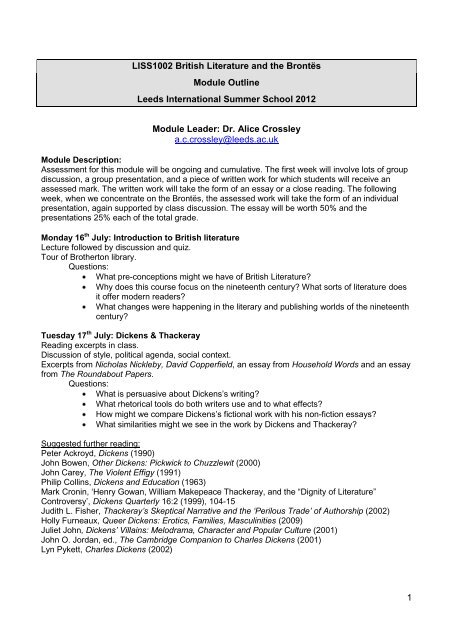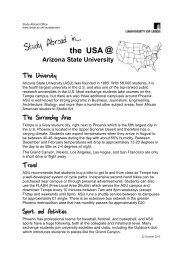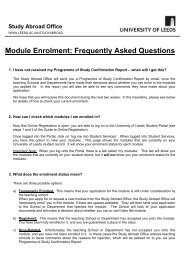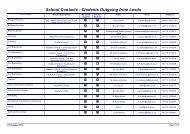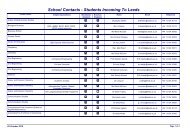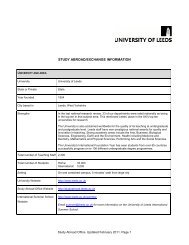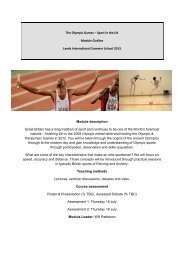British Literature and the Brontës - Study Abroad
British Literature and the Brontës - Study Abroad
British Literature and the Brontës - Study Abroad
Create successful ePaper yourself
Turn your PDF publications into a flip-book with our unique Google optimized e-Paper software.
LISS1002 <strong>British</strong> <strong>Literature</strong> <strong>and</strong> <strong>the</strong> <strong>Brontës</strong><br />
Module Outline<br />
Leeds International Summer School 2012<br />
Module Leader: Dr. Alice Crossley<br />
a.c.crossley@leeds.ac.uk<br />
Module Description:<br />
Assessment for this module will be ongoing <strong>and</strong> cumulative. The first week will involve lots of group<br />
discussion, a group presentation, <strong>and</strong> a piece of written work for which students will receive an<br />
assessed mark. The written work will take <strong>the</strong> form of an essay or a close reading. The following<br />
week, when we concentrate on <strong>the</strong> <strong>Brontës</strong>, <strong>the</strong> assessed work will take <strong>the</strong> form of an individual<br />
presentation, again supported by class discussion. The essay will be worth 50% <strong>and</strong> <strong>the</strong><br />
presentations 25% each of <strong>the</strong> total grade.<br />
Monday 16 th July: Introduction to <strong>British</strong> literature<br />
Lecture followed by discussion <strong>and</strong> quiz.<br />
Tour of Bro<strong>the</strong>rton library.<br />
Questions:<br />
What pre-conceptions might we have of <strong>British</strong> <strong>Literature</strong>?<br />
Why does this course focus on <strong>the</strong> nineteenth century? What sorts of literature does<br />
it offer modern readers?<br />
What changes were happening in <strong>the</strong> literary <strong>and</strong> publishing worlds of <strong>the</strong> nineteenth<br />
century?<br />
Tuesday 17 th July: Dickens & Thackeray<br />
Reading excerpts in class.<br />
Discussion of style, political agenda, social context.<br />
Excerpts from Nicholas Nickleby, David Copperfield, an essay from Household Words <strong>and</strong> an essay<br />
from The Roundabout Papers.<br />
Questions:<br />
What is persuasive about Dickens‟s writing?<br />
What rhetorical tools do both writers use <strong>and</strong> to what effects?<br />
How might we compare Dickens‟s fictional work with his non-fiction essays?<br />
What similarities might we see in <strong>the</strong> work by Dickens <strong>and</strong> Thackeray?<br />
Suggested fur<strong>the</strong>r reading:<br />
Peter Ackroyd, Dickens (1990)<br />
John Bowen, O<strong>the</strong>r Dickens: Pickwick to Chuzzlewit (2000)<br />
John Carey, The Violent Effigy (1991)<br />
Philip Collins, Dickens <strong>and</strong> Education (1963)<br />
Mark Cronin, „Henry Gowan, William Makepeace Thackeray, <strong>and</strong> <strong>the</strong> “Dignity of <strong>Literature</strong>”<br />
Controversy‟, Dickens Quarterly 16:2 (1999), 104-15<br />
Judith L. Fisher, Thackeray’s Skeptical Narrative <strong>and</strong> <strong>the</strong> ‘Perilous Trade’ of Authorship (2002)<br />
Holly Furneaux, Queer Dickens: Erotics, Families, Masculinities (2009)<br />
Juliet John, Dickens’ Villains: Melodrama, Character <strong>and</strong> Popular Culture (2001)<br />
John O. Jordan, ed., The Cambridge Companion to Charles Dickens (2001)<br />
Lyn Pykett, Charles Dickens (2002)<br />
1
Wednesday 18 th July: Pre-Raphaelites <strong>and</strong> Poetry<br />
Discussion of <strong>the</strong> aims <strong>and</strong> agenda of Pre-Raphaelite bro<strong>the</strong>rhood with reference toThe Germ<br />
(available as hypertext online).<br />
Reading <strong>and</strong> discussion of poems by D.G. Rossetti, Christina Rossetti, <strong>and</strong> A.C. Swinburne.<br />
Trip to <strong>the</strong> Leeds City Art Gallery with particular focus on <strong>the</strong> Pre-Raphaelite painting held <strong>the</strong>re<br />
(time permitting).<br />
Questions:<br />
What were <strong>the</strong> aims of <strong>the</strong> Pre-Raphaelite Bro<strong>the</strong>rhood?<br />
How might we define <strong>the</strong>ir success or failure with regards to <strong>the</strong>se aims?<br />
In what ways might we compare painterly strategies with poetic ones?<br />
Is it significant that <strong>the</strong> PRB was an all male group?<br />
Is it useful to consider Swinburne in relation to <strong>the</strong> Pre-Raphaelites?<br />
Suggested fur<strong>the</strong>r reading:<br />
Tim Barringer, Reading <strong>the</strong> Pre-Raphaelites (1999)<br />
Andrew Belsey <strong>and</strong> Ca<strong>the</strong>rine Belsey, „Christina Rossetti: Sister to <strong>the</strong> Bro<strong>the</strong>rhood‟,Textual<br />
Practice, 2:1 (1988), 30-50<br />
Joseph Bristow, ed., Victorian Women Poets: Emily Bronte, Elizabeth Barrett Browning, Christina<br />
Rossetti (1995)<br />
Alison Chapman, The Afterlife of Christina Rossetti (2000)<br />
Deborah Cherry, Painting Women: Victorian Women Artists (1993)<br />
Kate Flint, The Victorians <strong>and</strong> <strong>the</strong> Visual Imagination (2000)<br />
Ellen Harding, ed., Re-framing <strong>the</strong> Pre-Raphaelites: Historical <strong>and</strong> Theoretical Essays (1996)<br />
Antony H. Harrison, Victorian Poets <strong>and</strong> Romantic Poems: Intertextuality <strong>and</strong> Ideology (1990)<br />
Jerome McGann, Swinburne: An Experiment in Criticism (1972)<br />
Lynne Pearce, Woman/Image/Text: Readings in Pres-Raphaelite Art <strong>and</strong> <strong>Literature</strong> (1991)<br />
Elizabeth Prettejohn, The Art of <strong>the</strong> Pre-Raphaelites (2000)<br />
Herbert Sussman, Victorian Masculinities: Manhood <strong>and</strong> Masculine Poetics in EarlyVictorian<br />
<strong>Literature</strong> <strong>and</strong> Art (1995)<br />
Thursday 19 th July: Oscar Wilde<br />
Group Poster Presentations.<br />
Reading of The Importance of Being Earnest.<br />
Questions:<br />
How fluid is morality in Wilde‟s plays?<br />
Who plays <strong>the</strong> role of <strong>the</strong> d<strong>and</strong>y <strong>and</strong> what does that role bring to <strong>the</strong> plays?<br />
How <strong>and</strong> why are Wilde‟s plays comic?<br />
How does Wilde configure relationships between <strong>the</strong> sexes <strong>and</strong> between <strong>the</strong><br />
generations in his plays?<br />
Suggested fur<strong>the</strong>r reading:<br />
James Eli Adams, D<strong>and</strong>ies <strong>and</strong> Desert Saints: Styles of Victorian Manhood (Ithaca <strong>and</strong> New York:<br />
Cornell University Press, 1995)<br />
Patricia F. Behrendt, Oscar Wilde: Eros <strong>and</strong> Aes<strong>the</strong>tics (1991)<br />
Joseph Bristow, „Dowdies <strong>and</strong> D<strong>and</strong>ies: Oscar Wilde's Refashioning of Society Comedy‟, Modern<br />
Drama 37:1 (1994): 53-70.<br />
Karl Beckson, ed., Oscar Wilde: <strong>the</strong> Critical Heritage (1970)<br />
Richard Ellmann, Oscar Wilde (1987)<br />
Sos Eltis, Revising Wilde: Society <strong>and</strong> Subversion in <strong>the</strong> Plays of Oscar Wilde (1996)<br />
Regenia Gagnier, Idylls of <strong>the</strong> Market place: Oscar Wilde <strong>and</strong> <strong>the</strong> Victorian Public (1986)<br />
Josephine Guy <strong>and</strong> Ian Small, Oscar Wilde’s Profession: Writing <strong>and</strong> <strong>the</strong> Culture Industry in <strong>the</strong><br />
Late Nineteenth Century (2000)<br />
Norbert Kohl, Oscar Wilde: <strong>the</strong> Works of a Conformist Rebel (1989)<br />
2
Kerry Powell, Oscar Wilde <strong>and</strong> <strong>the</strong> Theatre of <strong>the</strong> 1890s (1990)<br />
Frederick S. Roden, ed., Palgrave Advances in Oscar Wilde Studies (2005)<br />
Peter Raby, ed., The Cambridge Companion to Oscar Wilde (1997)<br />
Alan Sinfield, The Wilde Century: Effeminacy, Oscar Wilde <strong>and</strong> <strong>the</strong> Queer Moment (1994)<br />
John Stokes, Oscar Wilde: Myths, Miracles <strong>and</strong> Imitations (1996)<br />
Friday 20th: Field Trip to Haworth <strong>and</strong> <strong>the</strong> Brontë Parsonage (inc. walk on <strong>the</strong> Moors)<br />
Week 1 assessment:<br />
A. 1 st Assessment: Group Presentation (25%)<br />
The assessment for <strong>the</strong> second week will be through a group poster presentation given on Day 4,<br />
on any text or issue raised in seminars or in preparatory research related to days 1-4 of <strong>the</strong> module.<br />
This will be set up on Day 1 when <strong>the</strong> module is introduced. There will be some class time devoted<br />
to preparation for this task, but it will be necessary for students to spend time on this outside<br />
class.The class will be divided into smaller groups <strong>and</strong> each will create a poster that will act as an<br />
aide when presenting back to <strong>the</strong> class.<br />
Students will need to:<br />
assess one or more of <strong>the</strong> critical approaches we have examined <strong>and</strong> demonstrate<br />
how it has shifted <strong>the</strong>ir interpretation of a text<br />
provide a close reading of a passage or poem of <strong>the</strong>ir choice<br />
address one or more of <strong>the</strong> <strong>the</strong>matic issues brought to light in class discussions<br />
Each group will need to divide <strong>the</strong> preparation equally, every member of <strong>the</strong> group must be involved<br />
in <strong>the</strong> presentation.<br />
B. 2 nd Assessment: Essay (50%)<br />
This will be set at <strong>the</strong> end of week1, <strong>and</strong> due at <strong>the</strong> end of week 2. Students to write an assessed<br />
essay or close-reading (max. 2000 words) on one of <strong>the</strong> following topics:<br />
- Write a close reading of one of <strong>the</strong> Dickens extracts or one of <strong>the</strong> poems we have studied this<br />
week. Pay close attention to language, rhetoric, metaphor, rhyme, rhythm, syntax <strong>and</strong> try to link<br />
<strong>the</strong>se points into your larger underst<strong>and</strong>ing of <strong>the</strong> function or purpose of <strong>the</strong> piece.<br />
- „…<strong>the</strong>se plays are all surface‟ (Neil Sammells, Wilde Style, 2000). Discuss this quotation with<br />
reference to ei<strong>the</strong>r The Importance of Being Earnest or A Woman of No Importance.<br />
- „What emerges from Dickens‟s prose are images of worlds in flux‟ (David Pascoe, Selected<br />
Journalism, 1997). Discuss this quotation with reference to <strong>the</strong> Dickens texts read in class.<br />
- How does morality function in Dickens or Wilde?<br />
- Compare <strong>the</strong> use of <strong>the</strong> female figure in poems by Dante Gabriel Rossetti <strong>and</strong> Christina<br />
Rossetti.<br />
- Compare representations of masculinity from two texts that we have studied in class.<br />
Monday 23 rd July: Introduction of <strong>the</strong> <strong>Brontës</strong>.<br />
Brief lecture.<br />
Reading <strong>and</strong> discussion of Jane Eyre.<br />
Reading of extracts from Elizabeth Gaskell‟s The Life of Charlotte Bronte, <strong>and</strong> class discussion<br />
Questions:<br />
Who were <strong>the</strong> <strong>Brontës</strong>? How do we differentiate between <strong>the</strong>m? What myths have<br />
grown up around <strong>the</strong>m?<br />
3
How does CB take us inside Jane Eyre‟s childhood consciousness?<br />
Why <strong>and</strong> how is Jane different from o<strong>the</strong>r children? Why might CB want to construct<br />
such a character?<br />
What might psychoanalytic or biographical approaches bring to <strong>the</strong> text? What are<br />
<strong>the</strong> drawbacks?<br />
How does our reading of feminist or post-colonial criticism such as Gilbert <strong>and</strong><br />
Gubar, or Spivak impact on our underst<strong>and</strong>ing of Jane Eyre?<br />
What role does religion play in <strong>the</strong> text?<br />
Why is education an important <strong>the</strong>me in <strong>the</strong> novel?<br />
What is troubling about <strong>the</strong> relationship between Rochester <strong>and</strong> Jane?<br />
Tuesday 24 th July: Jane Eyre<br />
DVD viewing of Jane Eyre, followed by reviews <strong>and</strong> discussion.<br />
Wednesday 25 th July: Jane Eyre<br />
Individual presentations on Jane Eyre.<br />
Thursday 26 th July: O<strong>the</strong>r <strong>Brontës</strong><br />
Group split up into smaller sections to read excerpts from o<strong>the</strong>r Brontë works, AB‟s The Tenant of<br />
Wildfell Hall, EB‟s Wu<strong>the</strong>ring Heights <strong>and</strong> EB‟s poetry.<br />
Discussion of differences <strong>and</strong> similarities between CB <strong>and</strong> AB/EB in terms of style <strong>and</strong> <strong>the</strong>me.<br />
Friday 27 th July: Field trip<br />
Suggested fur<strong>the</strong>r reading on <strong>the</strong> <strong>Brontës</strong>:<br />
Nancy Armstrong, Desire <strong>and</strong> Domestic Fiction: A Political History of <strong>the</strong> Novel (1987)<br />
Rachel K. Carnell, „Feminism <strong>and</strong> <strong>the</strong> Public Sphere in Anne Brontë‟s The Tenant of Wildfell Hall,<br />
Novel 30:1 (1996), 32-55<br />
Christina Colby, The Ends of History: Victorians <strong>and</strong> <strong>the</strong> ‘Woman Question’ (1991)<br />
Stevie Davies, Emily Bronte: The Artist as a Free Woman (1983)<br />
Terry Eagleton, Myths of Power: A Marxist <strong>Study</strong> of <strong>the</strong> <strong>Brontës</strong> (1975, 2nd ed 1988)<br />
Elizabeth Gaskell, The Life of Charlotte Brontë (1857)<br />
Janet Gezari, Last Things: Emily Brontë’s Poems (OUP, 2008)<br />
Hea<strong>the</strong>r Glen, ed., Cambridge Companion to <strong>the</strong> <strong>Brontës</strong> (2002)<br />
S<strong>and</strong>ra Gilbert <strong>and</strong> Susan Gubar, The Madwoman in <strong>the</strong> Attic: The Woman Writer <strong>and</strong> <strong>the</strong><br />
Nineteenth-Century Literary Imagination (1979).<br />
John Maynard, Charlotte Brontë <strong>and</strong> Sexuality (1984)<br />
Elsie Michie, “From Simianized Irish to Oriental Despots: Heathcliff, Rochester, <strong>and</strong> Racial<br />
Difference.” Novel 25 (1992): 125-40<br />
Julia Miele Rodas, „“On <strong>the</strong> Spectrum”: Rereading Contact <strong>and</strong> Affect in Jane Eyre‟, Nineteenth-<br />
Century Gender Studies 4: 2 (2008)<br />
Lucasta Miller, The Brontë Myth (2001)<br />
Julie Nash <strong>and</strong> Barbara A. Suess, eds. New Approaches to <strong>the</strong> Literary Art of Anne Brontë<br />
(Aldershot: Ashgate, 2001)<br />
Lorri N<strong>and</strong>rea, „Desiring Difference: Sympathy <strong>and</strong> Sensibility in Jane Eyre‟, in Novel: a forum on<br />
fiction 37 (2003), 112-134<br />
M. Jeanne Peterson, „The Victorian Governess: Status Incongruence in Family <strong>and</strong> Society‟, in<br />
Martha Vicinus, ed., Suffer <strong>and</strong> Be Still: Women in <strong>the</strong> Victorian Age (1972)<br />
Mary Poovey, Uneven Developments: The Ideological Work of Gender in Mid-Victorian Engl<strong>and</strong><br />
(London: Virago, 1989). Ch1 on „Uneven Developments‟ is interesting, as is Ch 5 on „The<br />
Ana<strong>the</strong>matized Race: The Governess <strong>and</strong> Jane Eyre‟<br />
Sally Shuttleworth, Charlotte Brontë <strong>and</strong> Victorian Psychology (1996)<br />
Gayatri Chakravorty Spivak, „Three Women‟s Texts <strong>and</strong> a Critique of Imperialism‟ Critical Inquiry<br />
12:1 (1985), 243-261<br />
Marianne Thormälen, The <strong>Brontës</strong> <strong>and</strong> Religion (1999)<br />
4
Week 2 assessment:<br />
C. 3 rd Assessment: Individual Presentations<br />
The assessment for <strong>the</strong> second week will be through an individual presentation given on Day 7.<br />
This will be set up on Day 5 when <strong>the</strong> <strong>Brontës</strong> are introduced. There may be some class time<br />
devoted to preparation for this task, but it will be necessary for students to spend more time on this<br />
outside class. Presentations must be on some aspect of Jane Eyre, although <strong>the</strong> specific focus of<br />
<strong>the</strong> presentation is up to each student.<br />
5


